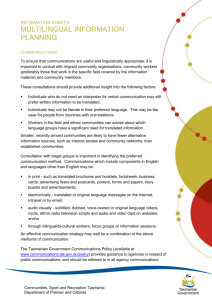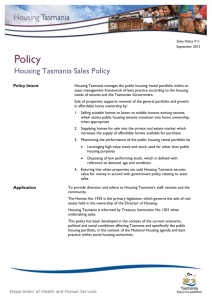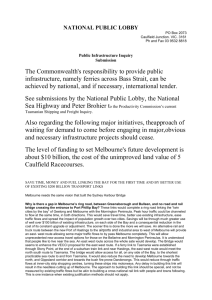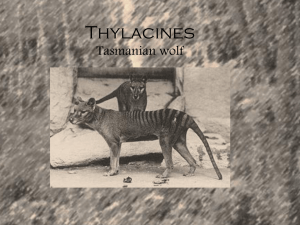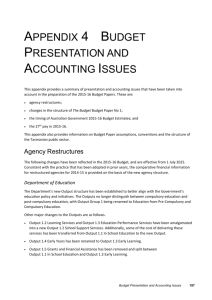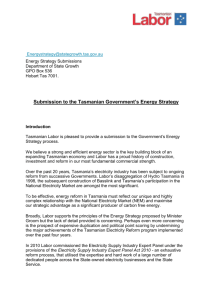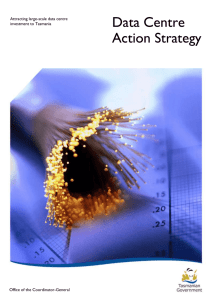Tasmanian Government Work Placement Program
advertisement
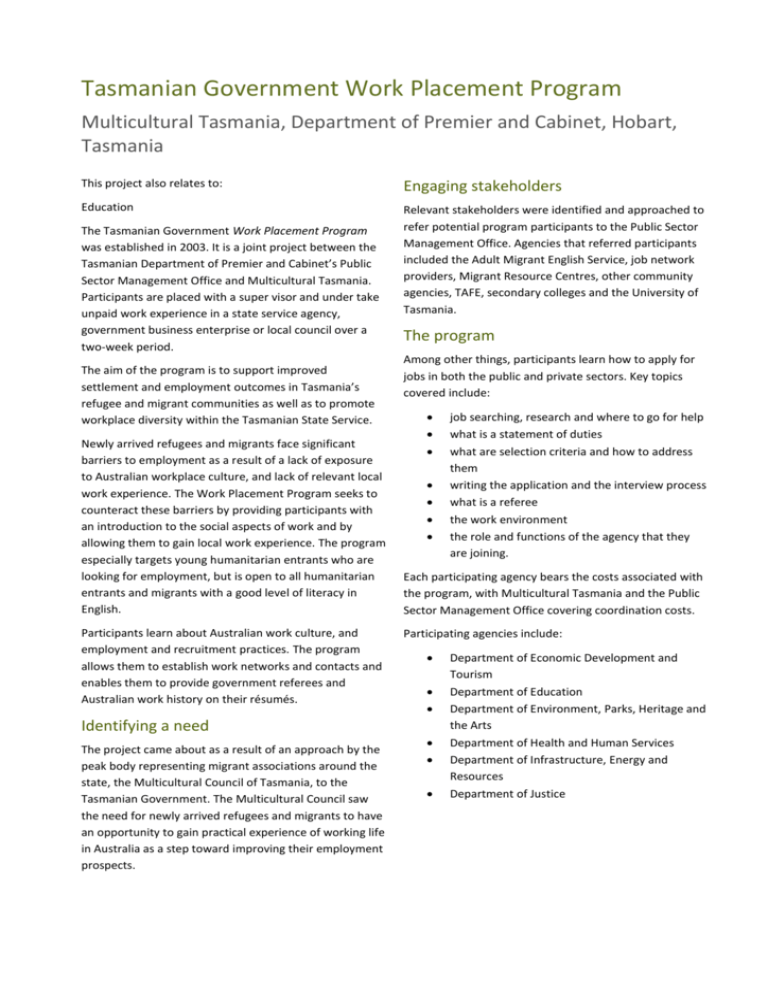
Tasmanian Government Work Placement Program Multicultural Tasmania, Department of Premier and Cabinet, Hobart, Tasmania This project also relates to: Engaging stakeholders Education Relevant stakeholders were identified and approached to refer potential program participants to the Public Sector Management Office. Agencies that referred participants included the Adult Migrant English Service, job network providers, Migrant Resource Centres, other community agencies, TAFE, secondary colleges and the University of Tasmania. The Tasmanian Government Work Placement Program was established in 2003. It is a joint project between the Tasmanian Department of Premier and Cabinet’s Public Sector Management Office and Multicultural Tasmania. Participants are placed with a super visor and under take unpaid work experience in a state service agency, government business enterprise or local council over a two-week period. The aim of the program is to support improved settlement and employment outcomes in Tasmania’s refugee and migrant communities as well as to promote workplace diversity within the Tasmanian State Service. Newly arrived refugees and migrants face significant barriers to employment as a result of a lack of exposure to Australian workplace culture, and lack of relevant local work experience. The Work Placement Program seeks to counteract these barriers by providing participants with an introduction to the social aspects of work and by allowing them to gain local work experience. The program especially targets young humanitarian entrants who are looking for employment, but is open to all humanitarian entrants and migrants with a good level of literacy in English. Participants learn about Australian work culture, and employment and recruitment practices. The program allows them to establish work networks and contacts and enables them to provide government referees and Australian work history on their résumés. The program Among other things, participants learn how to apply for jobs in both the public and private sectors. Key topics covered include: Each participating agency bears the costs associated with the program, with Multicultural Tasmania and the Public Sector Management Office covering coordination costs. Participating agencies include: Identifying a need The project came about as a result of an approach by the peak body representing migrant associations around the state, the Multicultural Council of Tasmania, to the Tasmanian Government. The Multicultural Council saw the need for newly arrived refugees and migrants to have an opportunity to gain practical experience of working life in Australia as a step toward improving their employment prospects. job searching, research and where to go for help what is a statement of duties what are selection criteria and how to address them writing the application and the interview process what is a referee the work environment the role and functions of the agency that they are joining. Department of Economic Development and Tourism Department of Education Department of Environment, Parks, Heritage and the Arts Department of Health and Human Services Department of Infrastructure, Energy and Resources Department of Justice Department of Police and Emergency Management Department of Premier and Cabinet Department of Primary Industries and Water Department of Treasury and Finance TAFE Tasmania Forestry Tasmania Government House Glenorchy City Council Hobart City Council. Supervisors of the participants attend a cross-cultural awareness session and receive background material and details of their participant prior to making contact and meeting them. Placements are for two weeks during the university semester break, in July. A variety of work options are provided including administrative and clerical, policy, finance, information technology, food services, laboratory, mechanical and maintenance. To recognise all those involved and to celebrate the success of the program, super visors and program participants attend a function hosted by the Minister for Community Development who presents participants with a Certificate of Achievement. Achievements The program successfully addresses barriers to employment by providing newly arrived refugees and migrants with the opportunity to gain an understanding of Australian workplace culture, local work experience and a local referee. The program also provides participating agencies with an opportunity to raise cultural awareness within Tasmania’s public service and promote workplace diversity. Reflecting community diversity within the state public service contributes to the achievement of the ‘Tasmania Together’ goal number five: Vibrant, inclusive and growing communities where people feel valued and connected (Tasmania Together is a long-term plan developed by Tasmanians for Tasmanians, outlining what the population wants to achieve by the year 2020). The program boasts close to a 100 per cent completion rate. In 2006, seven of the 21participants secured ongoing employment after completing the program. The success of the program has prompted organisers to negotiate placements with more government departments and local councils. Challenges The program is delivered with few dedicated resources. There is no overall budget that can be drawn on to help coordinate the program. Each participating agency must allocate resources from its own budget. Most positions in this program require good English language skills and this prohibits participation by those with limited English language skills. Each year, the range of host organisations and participant interests, goals, aspirations and level of qualifications vary. Matching participants with host agencies requires a high level of effort in order to maximize the benefits of the program. Key messages and advice for setting up a similar program It is important that participants are aware that it is a preemployment program and that there is no guaranteed job upon completion of the program. Contact details Multicultural Tasmania Level 2, 144 Macquarie Street Hobart Tasmania 7000 Phone: 03 6233 3439 Fax: 03 6233 2683 Email: multitas@dpac.tas.gov.au Profile - Stephanie Stephanie arrived in Australia in 2005 as a refugee from Sierra Leone. Stephanie had six years’ experience in West Africa as a secretary and administration manager. Just two weeks after arrival in Hobart, she was referred to the Work Placement Program in 2005 and was placed in Multicultural Tasmania’s office in an administrative role. Stephanie said: In two weeks, the Work Placement Program opened my eyes to the workplace culture in Australia, which is quite different to what I was used to. The people, the systems and even the type of English are different. In the part of Africa where I come from, there was a quite a margin between the boss and the subordinate. I found that here everyone is addressed the same way; even the head of the department, and everyone is able to participate in the workplace equally. I was doing administration work but found that I was able to learn from people in other parts of the office. At the end of the work placement, Stephanie was invited to fill a position at Multicultural Tasmania while the executive assistant was on leave for four weeks. After that, she applied for an opening in the public service and was soon appointed administrative officer in the office of Tasmanian Government Minister, Lara Giddings MHA. Stephanie said: It’s quite confronting when you get into a new society and find yourself not able to participate when you have the ability to do so. The work placement program helps in boosting your confidence and your ability to participate wherever you find yourself. Profile - Kiros Kiros came to Australia in 2006 with a wealth of work experience. After graduating from university in Ethiopia in Animal Sciences, he worked as a training officer and managed large projects in environmental sustainability, governance and water development, leading teams of up to 26 staff. Kiros is married to an Eritrean, and he was forced to leave his country of origin after war broke out with Eritrea. As a refugee in Kenya, he worked for the International Organization for Migration providing cultural orientation programs for refugees being resettled. When Kiros and his family were resettled in Hobart in March 2006, he sent his impressive résumé around to potential employers, but had no response. The Migrant Resource Centre of Southern Tasmania referred him to the Work Placement Program and, in July 2006, he participated in a two-week placement at the Land Titles Office of the Tasmanian Department of Primary Industries. Kiros describes the work placement as a wonderful experience. He recognises that getting a job involves not only what you know, but also who you can list as a local referee. Kiros said: Something has to be done to break down the barrier. You need people to be able to say confidently: ‘Yes, I know him. He is very good. He is competent. He can do that job.’ The only way that this can happen is for you to be able to express yourself in a work environment – and work placement allows you to do exactly that. Kiros would like to see the program expanded and believes private industry and Australian Government agencies should be encouraged to take it up. After the work placement, Kiros secured work for two days per week in a clerical role with the Land Titles Office. Soon after, he found full-time work as a Project Officer with a Migrant Resource Centre.
